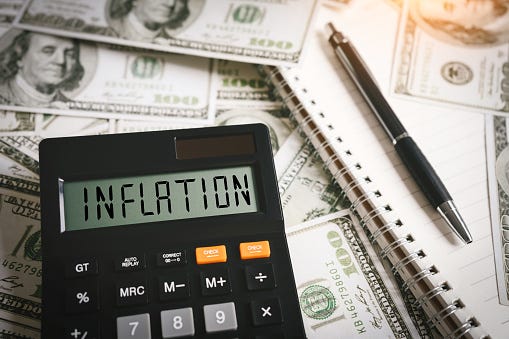As the Fed prepares to have its FOMC meeting on the 21st-22nd of Sept and is expected to raise the FFR by a historic 75–100 bps to curb rampant 40-yr high inflation, spending, and borrowing, we must wonder if this delayed hawkish move and additional rate hike will really be able to engineer a soft landing for the economy this time around.
Given the Fed has been sleeping behind the wheel for the past year and a half, except while day trading of course, since it pumped trillions into the economy to revive markets past March 2020’s correction, it’s now behind and has shaken companies and consumers’ wallets as a result.
Surprising, everyday consumers are continuing to spend like there’s no tomorrow thanks to the generous monetary and fiscal policy during the darkest days of the pandemic. Today, most Americans report they’re the most financially secure they’ve ever been! But let’s take that with a grain of salt since over 50% of Americans report having to go into debt to pay for an unexpected $1k expense…
With all the talk on the street around a looming recession and continued extensive sell-offs in the market, who knows if the Fed will be able to pull this off since its track record is quite murky however with a decent cash hoard, sizable equity in your primary residence (>80%), and minimal “toxic” debt as possible, no matter if the Federal Funds rate (FFR) continues to skyrocket, you should be able to weather any storm with 6–12 months of living expenses in cash on hand. It’s king after all.
Although the markets may have retreated from their epic rallies since May 2020, we’re witnessing one of the tightest, hottest labor and housing markets on record. Since interest rates have been at rock-bottom rates for decades, Americans are finally feeling the effects of increased rates however at a different scale than we anticipated since spending is still off the hook!
With gas prices down 40–60% since June highs, Americans are celebrating with even more revenge spending. Come time for the holidays, consumer confidence might abate however, for now, there are clear paradoxes on the consumer and economic front that directly contradict each other! No one knows what to make of this market these days since everything is backward!
Welcome to economics 101, which is driven by unpredictability, behavior, emotions, and humans, the most uncertain creatures who guide financial markets.

What To Cautiously Hawk Watch
Although growth has stalled due to lingering supply chain constraints, the Russia/Ukraine war, hiring freezes and of course, rampant inflation, spending, and slow growth continue to persist. The CPI Index disappointingly increased last month by 0.1% while economists predicted a 0.1% decline due to lower energy prices and an expected curb in spending.
So how resilient is the American consumer?
Although savings rates are at pitifully low levels around ~4% off a high from almost ~20% in the midst of the darkest days of the pandemic, you can read here about the unexpected upside to lower savings for the economy and possibly your wallet if diligent enough. Although this range is not recommended to follow especially in this environment where cash is pretty dominant, especially when yields have inverted and short-term treasuries offer higher rates on cash in the short-term, inflation must cool down somehow and that starts with the consumer to invest more than blow their cash.
Paradox #1: High Inflation | Slow Growth
This is one major paradox that has executives, analysts, economists, reporters, investors, and everyday Americans frizzled. While inflation is at all-time highs, growth is still relatively slow with Big Tech and big banks initiating job cuts and curbing hiring due to overspending, and lofty outrageous estimates on growth that did not last past lockdown, particularly in investment banking.
Paradox #2: Strong Tight Labor Market | Slower Wages Relative to Inflation
Another paradox that is the direct result of 40-yr high inflation is the tight, hot labor market. This is happening while wages aren’t keeping up with rising prices caused by slower corporate spending, hiring growth.
On the housing front, with the 15-fixed-rate mortgage rate reaching 6% on Monday, we’re already seeing building permits and mortgage applications slow, which allows potential home buyers to have even more buying power with more inventory on the market now and potentially be able to finally scoop up a decent deal for the first time in 2 years!
Since housing markets tend to cool off in the summer and winter months, sellers who are really eager to move out and find a new dream home see prospective buyers as more attractive than ever given there are fewer bidding wars and speculation compared to 2020–2021. As a result, deals are likely to close faster and at a more reasonable price than 20%-70% above asking when the buying-spree is out of control.
This telling example of how the housing market continues to benefit from rising and or falling rates is one of the main reasons why real estate is by far my favorite asset class. It takes up about 50% of my net worth as a 21-yr-old due to rising rents and the appreciable return from my crowdfunding investments and physical rentals I manage. Plus, it’s not only easier to time the real estate market than equities given real estate doesn’t encounter dramatic swings in price in a matter of minutes, but both sides (seller + buyer) have negotiating power as well!
This is why the housing market is such a powerful indicator in the economy since it’s a non-correlating inflationary-proof investment and illustrates true consumer behavior since, for most of us, our home is the most expensive purchase of our lives and isn’t a quick purchase.
Today, indicators such as housing permits, sluggish retail sales, pending layoffs/job cuts, and i.e. FedEx (shipping delivery companies) projections and estimates for following quarterly growth also hint at where the economy is headed.
However, in all of this analysis, there’s a paradox in itself.
As the great investors of our time pronounce, “to get ahead and make a true fortune, you have to go against conventional wisdom”.
Now you certainly don’t want to bet your entire life savings or retirement portfolio in crypto or that there won’t be a recession in 2023, however, setting aside no more than 30% of your capital into one invest or allocating a bit more of your net-worth into an asset that most people are wary of can be a prudent move. This can include farmland that benefit from rising commodity prices or even tapping into equities while the majority believe they’re in for an extensive sell-off in the months to come. As much as finding the golden goose helps, it’s also about what you avoid to help you go against the crowd.
As Buffett says, “be greedy when others are fearful” can be the best piece of advice you can hold onto during this paradoxical time when growth has slowed yet spending is up.
Against the backdrop of all this confusion, what to watch out for really boils down to retail sales and or income levels. Into this winter, credit bureaus, banks, and retailers will find out if delinquency rates, credit card borrowing, slower spending, defaults, or delayed payments tick.

The Paradoxical Horizon
It’s a reassuring sign that although less-capital intensive sectors such as Big Tech and fiancnail services are slowing spending with hiring freezes, the job market doesn’t seem to be cooling off. For the past few months, there have been a record number of job openings by employers, beating pre-pandemic numbers by 2x fold. Anyone who wants a job can pretty much find one now!
By the numbers, employers added 315,000 jobs last month and there were more than 11 million open positions at the end of July.
However, another paradox to watch out for is the surprising number of workers who remain on the sidelines while unemployment is still at record lows. The go-getter entrepreneurial wave that kickstarted during the pandemic prevailed! Staying diversified and building multiple income sources aren’t as tough anymore!
Paradoxical Paralysis!
Clearly any investor can go crazy with all these indicators and figures to watch out for. At the end of the day, you can only control so much and that starts with where you spend your time and what you choose to pay attention to.
All a true investor really yearns for is peace of mind, to not trade their money for time, and sleep soundly at night.
Similarly to when you start a venture, having too many resources, gadgets, tutors, etc. at your disposal can blindside you just like an investor with a Bloomberg Terminal and Motley Fool membership. Paradoxically, subscribing to anything that includes, ‘fool’, may or may not be a good choice. Less = More to not bombard and instead stick to logic.
As a glass-half-full kind of gal, knowing that inflation continues to be resilient and consumers are sensing lke there’s no tomorrow, indicates consumers can fully support themselves and not rely on Uncle Sam or Powell for stimulus.
How long will that last?
Well, that’s the billion-dollar question however when unemployment is at record lows, it’s certainly a healthy sign that no matter if wages are keeping up with inflation or not. Consumers are in a more diversified position than ever before.
Demand is skyrocketing and only time will tell how high inflation can go before it controls us.
Thankfully gas prices have cooled along with staple goods at the grocery store. As a result, maybe this will finally be the time to get your revenge body before we plunge into darkness at 3 pm in a few months and eat our way into the holidays.
A healthy body = a clear mind and better choices.
Without leaving you hanging with a poker face, here are a few factors to watch out for in this paradoxical world:
-Michigan Consumer Sentiment reading — currently lower than pre-pandemic — a good forecast on the strength of consumers’ balance sheets and how long they’ll hold up
-September’s CPI Index (Inflation) will be released in early October
-Fed rate hike results ~75–100bps impact in Q4
-Retail sales, travel rates
-Russia/Ukraine crisis and energy markets
-Monthly unemployment rate and job openings
-USD strength vs international and emerging markets inverse
See you on the other side!

